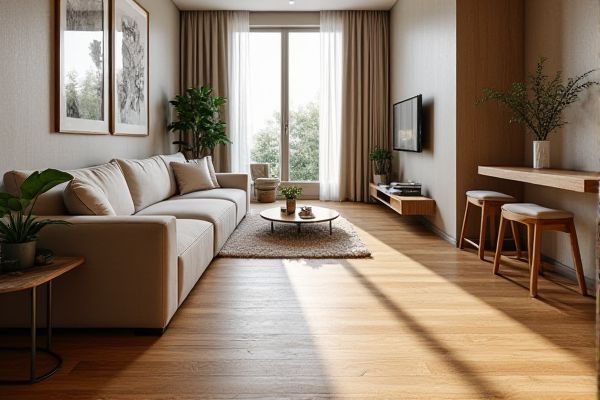
Plank flooring offers a sleek, modern look with wide boards that emphasize the natural grain of the wood, while parquet flooring showcases intricate geometric patterns that add a classic, decorative touch to any room. Discover the specific benefits and design possibilities of each option to determine which flooring best suits your style and needs in the full article.
Table of Comparison
| Feature | Plank Flooring | Parquet Flooring |
|---|---|---|
| Material | Long, wide wooden boards | Small wood pieces arranged in patterns |
| Design | Simple, linear look | Decorative, intricate patterns |
| Installation | Straightforward, faster | Complex, time-consuming |
| Durability | Good, dependent on wood type | Highly durable if properly maintained |
| Cost | Generally lower | Higher due to craftsmanship |
| Maintenance | Easy to clean, may require refinishing | Requires careful cleaning, periodic sealing |
| Common Wood Types | Oak, maple, pine | Oak, walnut, cherry |
| Best For | Modern, minimalist interiors | Classic, decorative spaces |
Introduction to Plank Flooring and Parquet Flooring
Plank flooring consists of long, wide wooden boards that highlight the natural grain and texture of the wood, offering a clean and contemporary look. Parquet flooring features small, geometric wood pieces arranged in intricate patterns, providing a classic and decorative aesthetic. Both options use hardwood materials but differ significantly in their design, installation techniques, and visual appeal.
Defining Plank Flooring
Plank flooring consists of long, wide boards made from solid wood or engineered materials that emphasize natural grain patterns and durability. This style offers a sleek, modern appearance and is easier to install and maintain compared to traditional parquet flooring, which features intricate geometric patterns created from smaller wood pieces. Your choice may depend on desired aesthetics, budget, and the level of craftsmanship you prefer for your space.
Understanding Parquet Flooring
Parquet flooring consists of small wood pieces arranged in intricate geometric patterns, offering a classic and decorative aesthetic compared to the broader, uniform boards of plank flooring. Its design allows for creative layouts and historical charm, often found in traditional or high-end interiors. You can choose parquet flooring to add texture and visual interest to your space while benefiting from durable hardwood materials.
Visual Aesthetics: Plank vs Parquet
Plank flooring offers long, wide boards that emphasize a clean, streamlined look with visible grain patterns, ideal for modern and rustic interiors seeking simplicity and spaciousness. Parquet flooring features intricate geometric patterns composed of smaller wood pieces, providing a decorative, classic aesthetic that adds texture and visual interest to your space. Your choice depends on whether you prefer the bold uniformity of planks or the artistic complexity of parquet designs.
Installation Process Comparison
Plank flooring installation typically involves tongue-and-groove systems that allow for straightforward floating, glue-down, or nail-down methods, making it accessible for DIY projects and quicker overall deployment. Parquet flooring installation requires meticulous arrangement of geometric patterns, often demanding professional expertise to ensure precision and durability, with options including glue-down or staple-down techniques. The complexity of parquet installation usually results in longer labor time and higher costs compared to the more straightforward process for plank flooring.
Durability and Maintenance
Plank flooring, crafted from wide single strips of solid wood or engineered layers, offers exceptional durability due to its thicker construction and resistance to warping, making it suitable for high-traffic areas. Parquet flooring, composed of small wood pieces arranged in geometric patterns, requires careful maintenance to prevent damage to its intricate designs and may be more susceptible to scratches and moisture. Both flooring types benefit from regular cleaning with a wood-safe cleaner and periodic refinishing to maintain their appearance and longevity.
Cost Differences
Plank flooring generally costs less than parquet flooring due to simpler manufacturing and installation processes. Parquet flooring involves intricate patterns and requires skilled labor, increasing both material and labor expenses. When planning your budget, consider that plank flooring offers a more economical option while parquet provides a distinct aesthetic with higher upfront costs.
Best Applications and Room Suitability
Plank flooring suits large, open spaces like living rooms and kitchens due to its wide boards that emphasize natural wood grain and create a spacious feel. Parquet flooring excels in smaller, formal areas such as dining rooms and foyers where intricate patterns like herringbone or basket weave add elegance and visual interest. Both flooring types offer durability but parquet's detailed design demands precise installation and suits rooms with lighter foot traffic for longevity.
Environmental Impact and Sustainability
Plank flooring often uses wider, single pieces of wood, requiring fewer trees and generating less waste, making it a more sustainable option when sourced from certified forests. Parquet flooring, with its intricate patterns made from smaller wood segments, can create more manufacturing waste and typically involves adhesives with higher VOC emissions. Choosing sustainably harvested wood with low-impact finishes enhances environmental benefits for both plank and parquet flooring options.
Choosing the Right Flooring for Your Home
Plank flooring offers wide, long boards that create a sleek, modern look with visible wood grain, making it ideal for spacious rooms and contemporary designs. Parquet flooring features intricate geometric patterns composed of smaller wood pieces, adding elegance and visual interest perfect for traditional or upscale interiors. Your choice depends on the style you prefer, room size, and maintenance needs, with plank flooring often easier to clean and parquet flooring providing a distinctive decorative appeal.
 homyna.com
homyna.com